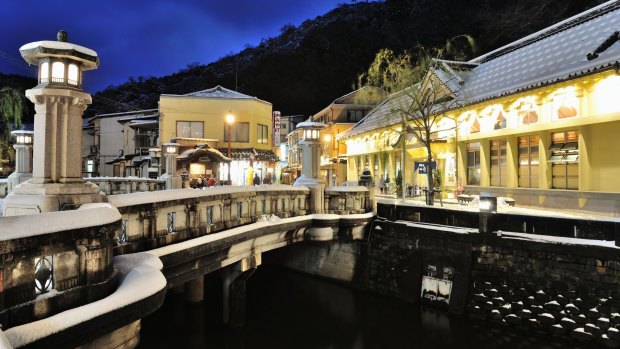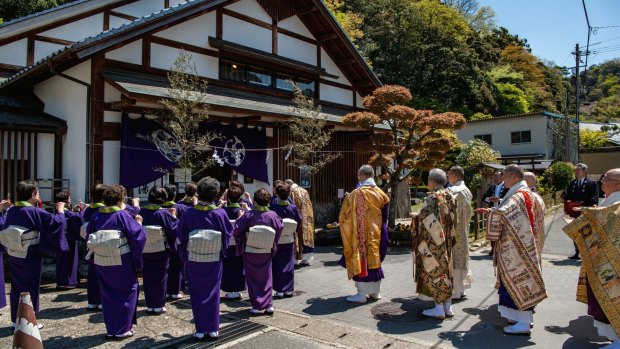
Kinosaki Onsen is a town that survives and thrives on the onsen trade.Credit: Toyooka City
Plenty of foreign visitors could make use of a journey up to Onsenji. Or at least, the Onsenji of old.
This Buddhist temple sits in the pine forest midway up Mount Daishi, overlooking the spa town of Kinosaki Onsen in western Japan. It's been a place of pilgrimage since the year 738, an ornate wooden structure dedicated to the legend of Dochi-Shonin, a monk who is said to have prayed for 1000 days to bring forth the natural hot springs that feed Kinosaki's onsen to this day.
For centuries, those hoping to visit the onsen would have to make the trek up to Onsenji before they were allowed to bathe. Here they would be given instruction on how to use the hot-spring baths properly, before being bequeathed a wooden ladle to prove to those below that they were ready for the experience.

Foreign tourists and domestic travellers alike come here to connect with traditional Japanese culture.
First-time visitors to Kinosaki these days have no such instruction, as they don't anywhere in Japan. Instead, you have to try to divine the etiquette of the onsen, to watch carefully and do as others do, to disrobe at the right time and wash with the correct vigour and bathe in a way that's socially and hygienically acceptable.
So many rules and considerations – and that was before the COVID-19 pandemic. What happens now?
I'm here to find out. How does onsen culture work in the time of COVID?
Since landing in Japan I've seen nothing but face masks. Hygiene is taken seriously here, in a country that took a notoriously long time to reopen to international tourism. The first meal I ate in Japan was at Haneda Airport, where a sign on my table said: "Please eat without talking."
COVID-19 safety measures in Japan are strict and they're slavishly adhered to - indoor mask mandates have now officially been dropped, and yet usage is still very high. So how does it work at an onsen, where bathers famously strip off all their clothes and climb into a steaming soup of humanity with some of their closest new friends?
Can it even work at all?
A short walk through Kinosaki Onsen confirms it can. This is a town that survives and thrives on the onsen trade, that sees itself as one large ryokan, or inn – its hotels the rooms, its restaurants the kitchen, and its seven public onsen the bathrooms.
Foreign tourists and domestic travellers alike come here to connect with traditional Japanese culture. The warm spring waters in Kinosaki are supposed to have medicinal value, but the town itself represents a chance for even the Japanese to tap into their own history and traditions, to stay in classic ryokans, to dress in beautiful yukata robes and geta, the wooden flip-flops, and to visit onsen to socialise and relax.
Today, the narrow streets of Kinosaki are still punctuated by the equine clip-clop of geta on concrete, as yukata-clad families and couples shuffle from onsen to onsen, choosing the venue that suits their mood.
What are the COVID safety measures in Japanese onsen? Essentially, there are no COVID safety measures in Japanese onsen.
Much like Japan's cherished drinking and dining culture, you just can't do this while maintaining a strict level of distancing and cover. You can't be expected to strip all of your clothes off but keep your face mask on to climb into a pool whose waters are tipping 42 degrees. You can only maintain so much distance from strangers when you're all in a small pool together.
Yes, there are signs encouraging hand-washing, and temperature checks are made on the way in, but after that, onsen work in the way they have always worked. Everyone relaxes. History and tradition take over.
I manage to visit four of the seven onsen in Kinosaki, clip-clopping my way between them in wooden footwear provided free by my ryokan. You're not forced to dress traditionally here – though, why wouldn't you? We travellers are always looking to break into local culture in ways that are organic and natural. This is one of them.
And so I soak underneath the eaves of a natural cave at Ichino-yu; I bask in the rooftop pool at Satano-yu; I relax in the cold air at Kono-yu; and take in the traditional, Kyoto-style design at Goshono-yu.
These onsen work the way they always have – the way they always will.
THE DETAILS
VISIT
Visits to Kinosaki Onsen can be woven into any bespoke journey with Inside Japan. The company's "Essential Honeymoon Self-Guided Adventure" is an 11-night tour that includes accommodation, transport and some meals and activities, with one night in Kinosaki, and costs $4068 per person. See insidejapantours.com
MORE
Ben Groundwater was a guest of Toyooka City.
Sign up for the Traveller Deals newsletter
Get exclusive travel deals delivered straight to your inbox. Sign up now.